During the Joseon Dynasty, the Hangang river’s frequent floods relegated Yeouido island (여의도) to pastureland and peanut fields; indeed, the name Yeouido means, “Useless Island.”

Japanese colonial authorities built Korea’s first airport there in 1929. But it, too, succumbed to the Hangang. It wasn’t until a bridge linking Yeouido to the mainland was built in 1970 that development began in earnest.
Fast-forward to today and Yeouido is the home of Seoul’s financial, political and broadcasting worlds. The best way to see it all? A bicycle tour of Yeouido and Seonyudo!

Although the so-called “Manhattan of Seoul” is no longer useless, what happens inside its sturdy towers may be of little consequence to most visitors.
The business people who work there walk on wide sidewalks that lack the spirit of many Seoul neighborhoods.
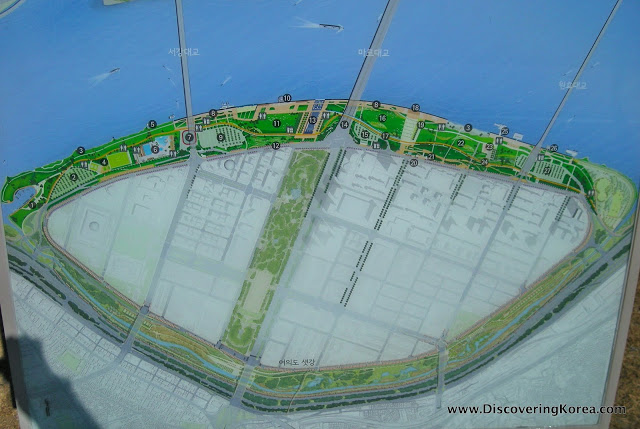
Nevertheless, tucked here and there are delicious places to eat, worthwhile attractions, and some of the city’s best green spaces.
Touring 3 Parks on 2 Wheels
A bicycle tour of Yeouido and Seonyudo should begin on the bigger of the two islands. Yeouido’s oval-shaped perimeter is all park.
The Yeouido Saetgang Ecological Park (샛강생태공원) lines its south bank, while its north side is part of the Hangang riverside parks network.
There’s even more green in-between. Yeouido Park (여의도공원) is an attractive, 23-hectare plot situated where airplanes once landed. A large blacktop remains, but these days, bicycles and roller blades are cruising the tarmac.
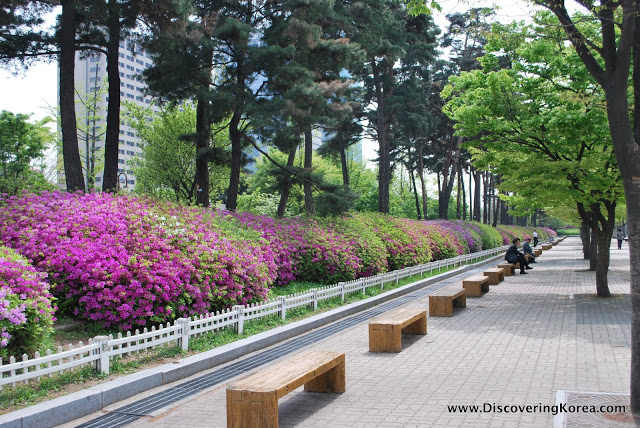
If you didn’t bring your own bicycle, don’t worry – for 3,000 won you can rent one.
Before setting off on a bicycle tour, however, I’d recommend lunch.
Jinju Jip is renowned for Seoul’s best kongguksu (콩국수), or noodles served in a chilled soybean broth. Located beneath the Yeouido Department Store, the restaurant’s unremarkable interior won’t distract you from devouring a summertime favorite.
For the carnivores, there’s Changgo 43. The restaurant specializes in a 180g slab of succulent Korean beef so tender it’s easily sliced with a plastic spatula.
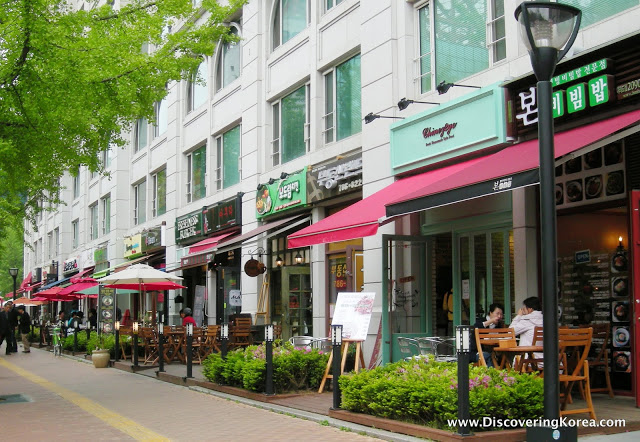
Once your hunger is satisfied, I’d recommend picking up that bike and riding northward. The Hangang Park’s Yeouido section was completely redone in 2009 as part of the “Hangang Renaissance Project.”
The 25-year plan is to rehabilitate the river and transform it into a world-class attraction. For Yeouido, that meant building a floating amphitheater and a large water fountain.
Even more surprising is what’s underneath the Mapodaegyo Bridge – a “Color Park” depicting Seoul’s official color palette.
Pretty in Pink
Pink is not among Seoul’s official colors, but the curving pink tower on Yeouido’s eastern tip is one of the city’s signature buildings.
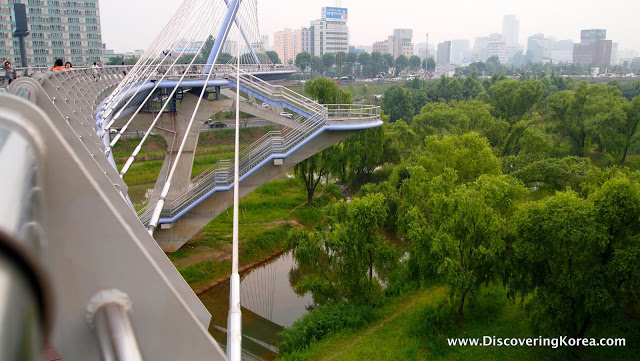
Briefly the tallest outside North America, the 63 Building (육삼빌딩) – named for its 60 above- plus three below- stories – is a popular destination that holds Korea’s first public aquarium, Seoul’s first wax museum, and the Sky Café, whose top floor location affords some of the city’s best views.
From up on high, you would be forgiven if the words, “This is an island?” came to mind. Yeouido fits snugly against the Hangang’s southern bank; in fact, only a narrow stream separates it from the mainland.
But these wetlands, known as the Yeouido Saetgang Ecological Park, are an attractive setting to continue your tour. Large willow trees and reeds camouflage various fish, fowl and even rabbits.
Under construction is an ultra-modern, 354-meter footbridge that will cross the marsh and connect the island’s growing number of skyscrapers to Yeongdeungpo-gu.
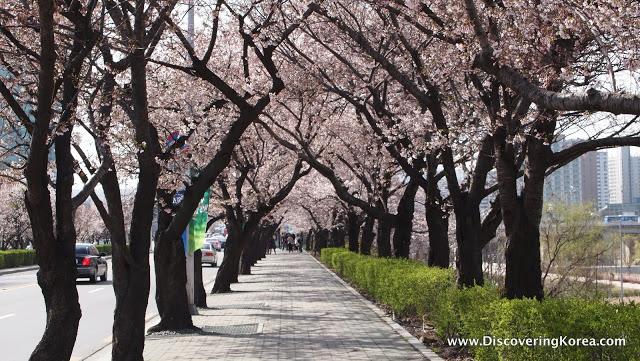
As you pedal towards Yeouido’s west end, the green copper dome of South Korea’s National Assembly comes into view. You could take a guided tour of the country’s parliament, but the real attraction occurs outside each spring, when 1,400 flowering cherry trees cover Yeouiseo-ro Street in pink petals.
Staying Focused on a Wandering Isle
Having reached Yeouido’s western tip, if you turned your handlebars to the left, after about 1.5 kilometers, you’d arrive at the Rainbow Bridge.
Designed by Rudy Ricciotti and presented as a gift to South Korea from France in 2000, the bridge leads to Seonyudo, another island with a compelling story.
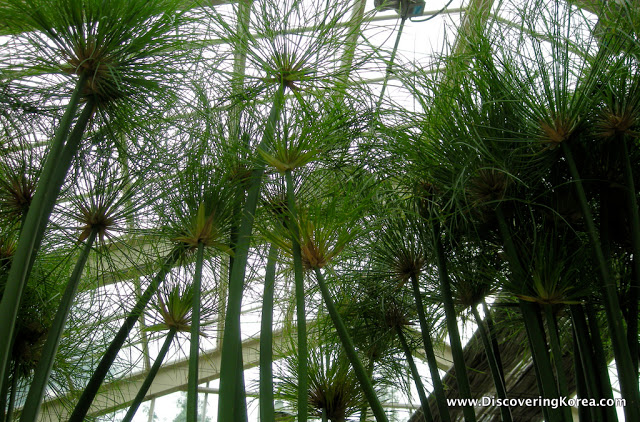
We continue our bicycle tour of Yeouido and Seonyudo with a look back at the Joseon Dynasty, when Seonyudo island (선유도) was a favorite destination for wandering Confucian scholars called seonbi, who went there to paint and compose poetry.
During the Japanese colonial period, however, its picturesque cliffs were flattened, and in 1978 the island was turned into a sewage treatment plant.
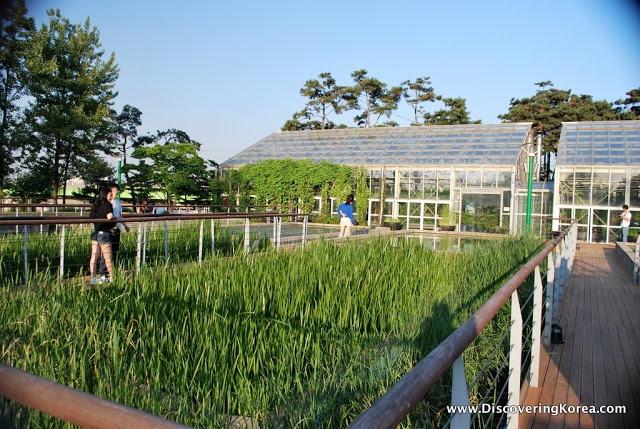
In 2003, as part of the Hangang Renaissance Project, the island was re-opened as an eco-consciousness park. Described by the city as a “post-modern space,” the award-winning park integrates the old treatment plant’s structures into a series of water-themed gardens.
For example, bygone settling basins for chemicals are now home to small fish and species of aquatic plants that naturally purify water.
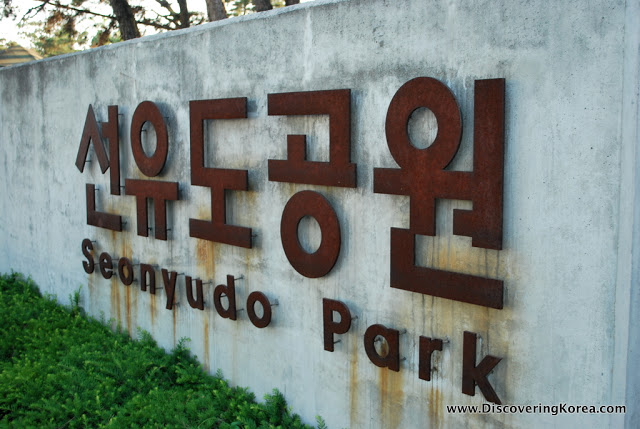
In addition to the botanical gardens, the Hangang History Museum, a 200-seat amphitheater and Naru Café are also located on Seonyudo. The café offers simple snacks and a great place to relax and watch the river.
As you wonder how so much nature could be found amidst a huge city like Seoul, we conclude our bicycle tour of Yeouido and Seonyudo… just don’t forget to return that bicycle.
For Your Information…
| Open: | Hangang riverside parks are open 24 hours. |
| Admission Price: | Free. Bicycle rentals are typically 3,000 won per hour. |
| Address: | Seonyudo and Yeouido are both located in Yeongdeungpo-gu district |
| Directions: | Yeouido can be reached via Yeouinaru Station on Lines 5+9, Exits 3-4.Seonyudo can be reached via Seonyudo Station (#912) on Line 9, Exit 2 (or take a taxi from Exit 1). |
| Phone: | 02-1330 |
| Website: |
About Matt Kelley
Matt Kelly is native of the US Pacific Northwest and is half-Korean by ethnicity. He lived in Korea for five years and has written hundreds of travel guides for Wallpaper, TimeOut, the Boston Globe and Seoul Magazine and was a host for several different variety shows on Korean radio and television.
